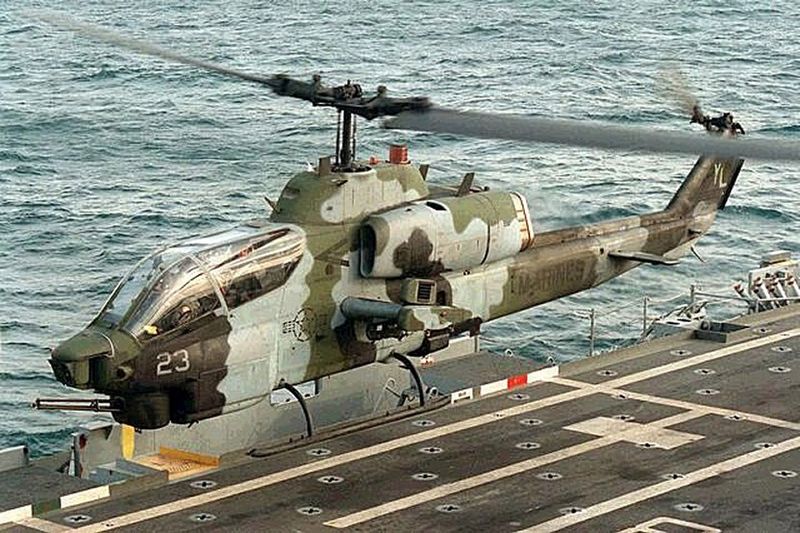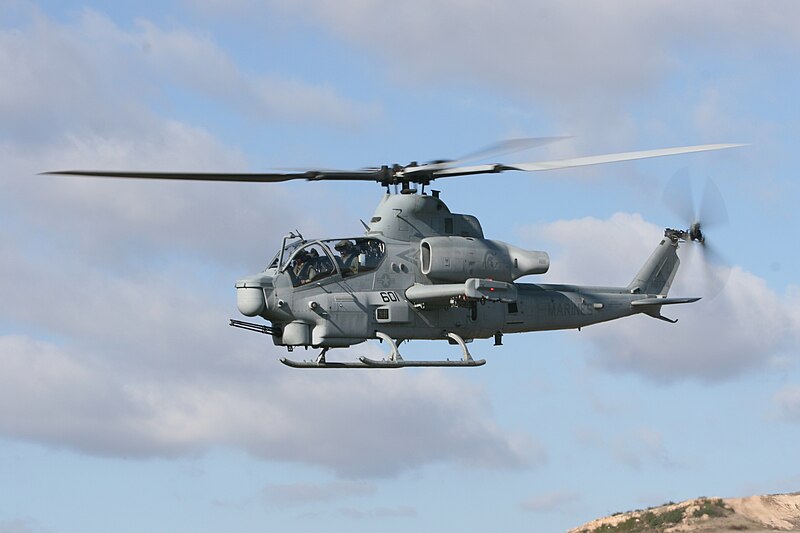A129 Mangusta
The Agusta A129 Mangusta (English: Mongoose) is an attack helicopter originally designed and produced by Agusta in Italy. It was the first attack helicopter to be designed and produced wholly in Western Europe. The TAI/AgustaWestland T-129 ATAK is an enhanced version of the A129, and its development is now the responsibility of Turkish Aerospace Industries (TAI), with AgustaWestland as the primary partner.

Bell AH-1 Cobra
The Bell AH-1 Cobra (company designation: Model 209) is a two-bladed, single engine attack helicopter manufactured by Bell Helicopter. It shares a common engine, transmissionand rotor system with the older UH-1 Iroquois. The AH-1 is also referred to as the HueyCobra or Snake.
The AH-1 was the backbone of the United States Army's attack helicopter fleet, but has been replaced by the AH-64 Apache in Army service. Upgraded versions continue to fly with the militaries of several other nations. The AH-1 twin engine versions remain in service with United States Marine Corps as the service's primary attack helicopter. Surplus AH-1 helicopters have been converted for fighting forest fires. The United States Forest Service refers to their program as the Firewatch Cobra. Garlick Helicopters also converts surplus AH-1s for forest firefighting under the name, FireSnake.[2]

Bell AH-1 SuperCobra
The Bell AH-1 SuperCobra is a twin-engine attack helicopter based on the US Army's AH-1 Cobra. The twin Cobra family includes the AH-1J SeaCobra, the AH-1T Improved SeaCobra, and the AH-1W SuperCobra. The AH-1W is the backbone of the United States Marine Corps's attack helicopter fleet, but will be replaced in service by the Bell AH-1Z Viperupgrade in the next decade.

Bell AH-1Z Viper
The Bell AH-1Z Viper[3] is a twin-engine attack helicopter based on the AH-1W SuperCobra, that was developed for the United States Marine Corps. The AH-1Z features a four-blade, bearingless, composite main rotor system, uprated transmission, and a new target sighting system.[4] The AH-1Z is part of the H-1 upgrade program. It is also called "Zulu Cobra" in reference to its variant letter.

Boeing AH-64 Apache
The Boeing AH-64 Apache is a four-blade, twin-engine attack helicopter with tailwheel-type landing gear arrangement, and tandem cockpit for a crew of two. The Apache was developed as Model 77 by Hughes Helicopters for the United States Army's Advanced Attack Helicopter program to replace the AH-1 Cobra. First flown on 30 September 1975, the AH-64 features a nose-mounted sensor suite for target acquisition and night vision systems. The Apache is armed with a 30-millimeter (1.2 in) M230 Chain Gun carried between the main landing gear, under the aircraft's forward fuselage. It has four hardpoints mounted on stub-wing pylons, typically carrying a mixture of AGM-114 Hellfire and Hydra 70 rocket pods. The AH-64 also features double- and triple-redundant aircraft systems to improve survivability for the aircraft and crew in combat, as well as improved crash survivability for the pilots.
The U.S. Army selected the AH-64 over the Bell YAH-63 in 1976, awarding Hughes Helicopters a pre-production contract for two more aircraft. In 1982, the Army approved full production. McDonnell Douglas continued production and development after purchasing Hughes Helicopters from Summa Corporation in 1984. The first production AH-64D Apache Longbow, a greatly upgraded version of the original Apache, was delivered to the Army in March 1997. AH-64 production is continued by the Boeing Defense, Space & Securitydivision; over one thousand AH-64s have been produced to date.
The U.S. Army is the primary operator of the AH-64, however it has also become the primary attack helicopter of several nations it has been exported to, including the United Kingdom,Israel, Japan, Greece and the Netherlands. U.S. AH-64s have served in conflicts in Panama, Persian Gulf War, Kosovo War, Afghanistan, and Iraq. Israel has made active use of the Apache in its military conflicts in Lebanon and Gaza Strip; while two coalition allies have deployed their AH-64s in Afghanistan and Iraq.

AgustaWestland Apache
The AgustaWestland Apache is a licence-built version of the Boeing AH-64D Apache Longbow attack helicopter for the British Army. The first eight helicopters were built by Boeing; the remaining 59 were assembled by Westland Helicopters (now part of AgustaWestland) at Yeovil, England from Boeing-supplied kits. Changes from the AH-64D include Rolls-Royce engines, a new electronic defensive aids suite and a folding blade mechanism allowing the British version to operate from ships. The helicopter was named "WAH-64" by Westland Helicopters. It is designated Apache AH Mk 1 (or shortened to Apache AH1) by the UK's Ministry of Defence.

Denel AH-2 Rooivalk
The Denel AH-2 Rooivalk (previously designated CSH-2) is an attack helicopter manufactured by Denel of South Africa. Rooivalk is Afrikaans for "Red Kestrel".[2]
The South African Air Force (SAAF) has ordered 12 Rooivalk AH-2As, the first of which entered service in July 1999. The helicopters are flown by 16 Squadron, which is based at AFB Bloemspruit near Bloemfontein.

Eurocopter Tiger
The Eurocopter Tiger (company designation EC 665) is an attack helicopter manufactured by Eurocopter. In Germany it is known as the Tiger; in France and Spain it is called theTigre.

HAL Light Combat Helicopter
The HAL Light Combat Helicopter (LCH) is a multirole combat helicopter being developed in India by Hindustan Aeronautics Limited (HAL) for use by the Indian Air Force and the Indian Army.

Kamov Ka-50
The Kamov Ka-50 "Black Shark" (Russian: Чёрная акула; Chornaya Akula, NATO reporting name: Hokum A) is a single-seat Russian attack helicopter with the distinctive coaxial rotor system of the Kamov design bureau. It was designed in the 1980s and adopted for service in the Russian army in 1995. It is currently manufactured by the Progress company inArsenyev.
During the late 1990s, Kamov and Israel Aerospace Industries developed a tandem-seat cockpit version, the Kamov Ka-50-2 "Erdogan", to compete in Turkey's attack helicopter competition. Kamov also designed another two-seat variant, the Kamov Ka-52 "Alligator" (Russian: Аллигатор, NATO reporting name: Hokum B).[4]

Mil Mi-24
he Mil Mi-24 (Cyrillic Миль Ми-24, NATO reporting name 'Hind') is a large helicopter gunship (and attack helicopter)[1] and low-capacity troop transport (Carries 8) produced by Mil Moscow Helicopter Plant and operated from 1972 by the Soviet Air Force, its successors, and over thirty other nations. In October 2007, the Russian Air Force announced it would replace its 250 Mi-24 helicopter gunships with 300 more modern Mi-28s and possibly Ka-50s by 2015.[2][3]
In NATO circles the export versions, Mi-25 and Mi-35, are simply denoted with a letter suffix as "Hind D" and "Hind E" respectively. Soviet pilots called the aircraft летающий танк(letayushchiy tank, “flying tank”). More common unofficial nicknames were Крокодил (Krokodil, “Crocodile”), due to the helicopter's new camouflage scheme[4] and Стакан (Stakan, “Glass”), because of the flat glass plates which surround the three place cockpit of the Mi-24A.

Mil Mi-28
The Mil Mi-28 (NATO reporting name 'Havoc') is a Russian all-weather day-night military tandem two-seat anti-armour attack helicopter. It is a dedicated attack helicopter with no intended secondary transport capability, better optimized than the Mil Mi-24 for the anti-tank role. It carries a single gun in an undernose barbette, plus external loads carried on pylons beneath stub wings.






